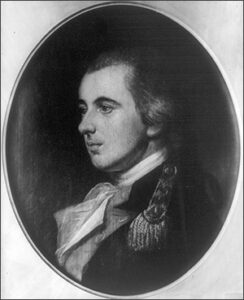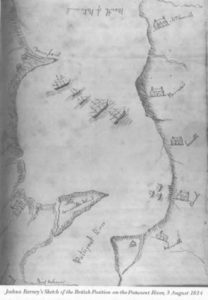 As the War of 1812 dragged on, a momentous explosion occurred on the Patuxent River, near modern day Wayson’s Corner on August 22, 1814. Commodore Joshua Barney, a revered Revolutionary War hero, brought back into service to help build the US Navy and defend against the British ordered his own sloop, the Flagship USS Scorpion to be blown up! Along with the balance of his rag tag fleet of gunboats, row galleys, and commandeered schooners.
As the War of 1812 dragged on, a momentous explosion occurred on the Patuxent River, near modern day Wayson’s Corner on August 22, 1814. Commodore Joshua Barney, a revered Revolutionary War hero, brought back into service to help build the US Navy and defend against the British ordered his own sloop, the Flagship USS Scorpion to be blown up! Along with the balance of his rag tag fleet of gunboats, row galleys, and commandeered schooners.
But Wait– …. Why would he do that!?
British Admiral Sir George Cockburn wrote “.… I plainly discovered Commodore Barney’s broad pendant in the headmost vessel, a large sloop and the remainder of the flotilla extending in a long line astern of her. Our boats now advanced towards them as rapidly as possible, but on nearing them, we observed the sloop bearing the broad pendant to be on fire, and she very soon afterwards blew up. I now saw clearly that they were all abandoned and on fire with trains to their magazines, and out of the seventeen vessels which composed this formidable and so much vaunted flotilla sixteen were in quick succession blown to atoms, and the seventeenth, in which the fire had not taken, was captured.“
The British Navy had been rampaging through the Tidewater, and port towns on the Chesapeake and Delaware Bays were under blockade. By 1813, the British were terrorizing the locals, burning tobacco plantations and stores to the ground on the upper Bay, and on the Patuxent River, and they were threatening to attack Washington, Baltimore, or Annapolis. With scant resources to defend the Bay, Joshua Barney came out of retirement and proposed a plan for the “Defense of the Chesapeake, ” to the Secretary of the Navy William Jones. A Baltimore native, he quickly assembled a flotilla of armed barges or shallow-bottomed “row-galleys,” to combat the British blockade and raiders. His flotilla set out in early 1814 with twelve barges, two gunboats, and the flagship sloop the USS Scorpion.
Barney’s maritime life, starting at age thirteen, was filled with adventure. During the Revolutionary War, Barney became the youngest Commander of a Continental Navy frigate. After England’s defeat in America, Barney went to Paris to deliver peace documents to Benjamin Franklin, even meeting Marie Antoinette while there! Back in the United States, his pride was hurt by not receiving expected honors, and so he sought recognition elsewhere. He became a French Navy commander in 1795 for five years before returning to Maryland. In 1812, at fifty-three, Barney, living in Elk Ridge, was barred from leading the U.S. Navy due to his service for France, but commanded the schooner Rossie on the Chesapeake, capturing 18 prizes until winter weather paused operations.
By December 1812, the Royal Navy was rampaging through the Tidewater region. As the British invaded the Eastern Shore, the American army was focused in Canada, leaving the Chesapeake relatively undefended. America’s forces had limited reinforcements and funds. It was in August 1813, that Barney was appointed commander of the Chesapeake Flotilla, and shipyards started building barges. News of the flotilla spread, prompting the British to set up an outpost, and begin building their own shallow-drafted barges on Tangier Island. The flotilla crew Barney assembled was about 500 men and was diverse: Navy sailors, privateers, watermen, runaway slaves, and free African Americans, including Charles Ball, a seaman and cook. By May 31, the Flotilla reached Drum Point to cross the bay and attack Tangier from the north. The very next day, a British scouting party encountered the Americans, with Captain Robert Barrie exploring Chesapeake inlets for Barney and realizing he was outgunned, signaling for help. Barney then pursued.

Rough waters hampered the shallow-draft American vessels as they entered the bay, allowing Barrie to pull ahead. Barney kept the chase until HMS Dragon, a 74-gun ship-of-the-line lurking in the Potomac, appeared after hearing Barrie’s signal guns. Now overmatched, Barney reversed course for the Patuxent. The British chased one American schooner, but Barney turned to fight when they threatened gunboat No. 137, which carried most of their supplies. Anchoring off Cedar Point, Barney’s boats exchanged fire with the British, forcing Barrie to pull back and allowing the Americans to slip into the Patuxent. The river resembles a link of sausages, with wide stretches of river interspersed with land spits, constricting waters to less than half a mile. Shoals and tidal surges complicated navigation, requiring caution from larger ships’ captains. Barrie stayed with a Patuxent blockade until he could gather enough shallow-draft, oar-driven boats to face Barney’s fleet.
Despite the optimistic vision, the hasty construction and lack of testing of the flotilla led to problems very early on. The main force of the flotilla quickly found itself bound up the Patuxent River, and eventually driven into the safety of the even shallower St. Leonard’s Creek by British vessels Dragon and St. Lawrence. After two engagements with the British, and the scuttling of gun boats, Barney was able to regain access into the main channel of the Patuxent River but still not reach the Chesapeake proper. The flotilla spent the remainder of the summer being pushed further and further up the river.
As Barney engaged in a months-long game of maritime cat and mouse, using his shallow draft vessels tactically. He would tuck up in shallow coves along the Patuxent River, where deep draft British vessels were unable to go, then attack, harass or create diversions, effectively holding the mighty British Navy at bay. But Barney’s scrappy luck finally ran out on August 22, 1814. Learning of an impending British attack on Washington DC, Barney and his flotilla men ran the fleet up into the shallows of the Patuxent River just north of Pig Point and Jug Bay. Barney ordered the fleet “scuttled,” destroying and burning many to the waterline to prevent them falling into British hands.
Leaving one-hundred and twenty men on the Patuxent to finish scuttling the flotilla, Barney and about four hundred men then headed to Washington on foot– to the doomed Battle of Bladensburg where he would receive a musket-ball to the leg. While he was unable to stop the British advance, his heroism and resolve on the Patuxent River may have given Dolley Madison the extra time she needed to collect the valuables from the White House and usher them to safety!
Get out and explore the Patuxent River: History abounds along the river, from Native American camps and villages to colonial sites, to the location of old steamboat wharves. Large swaths of protected and parkland on both sides of the Patuxent help preserve this amazing waterway and its natural environment.

Visit Jug Bay Wetland Sanctuary: Anne Arundel County and the non-profit Friends of Jug Bay manage and conserve several parcels along the Patuxent River that offer pristine water views where you can enjoy a natural experience exploring its forests, wetlands, marsh, creeks, meadows, and abundant wildlife.
- JBWS is celebrating its 40th Anniversary this year, Celebrate with them on September 27th with Music by the Marsh and learn more about their internationally known environmental research programs and conservation efforts
- The main sanctuary is a great place to start at their visitors center, then you can explore other nearby park assets including the Glendening Preserve; Patuxent Wetland Park and Fishing Pier , and Wootens Landing and Cartop Boat Launch
- Don’t have your own boat!? Join Jug Bay and Anne Arundel County Rec & Parks for a “Paddle Play Day” at the Emory Waters Preserve on Aug 30 from 10-2pm. Free but Registration Required
- Want to get more engaged? VOLUNTEER with Jug Bay!
The Lost Towns Project Archaeology Lab- This non profit works closely with Anne Arundel County to support technical, scholarly, and intellectual work of academics, professionals, and students. Want to learn more about archaeology on the Patuxent?
- Watch this video about archaeology at Jug Bay;
- Explore the “Native American Archaeology in Anne Arundel County, Maryland: A Heritage Toolbox,” designed for students, teachers, and the curious public to share exciting local archaeological discoveries;
- or get your hands dirty by volunteering at the County’s Archaeology Lab on Tuesdays or Wednesdays. No experience needed & families are welcome. Space is limited so reservation is required. Sign Up Here
To Learn More About the War of 1812 on the Patuxent River, Check out the Jefferson Patterson Museums Blog, or Visit:
The Naval Academy Visitor Center -The Visitor Center is the first stop on a visit to the undergraduate College of the U.S. Navy and U.S. Marine Corps. Information Specialists welcome visitors to view the 13-minute film, The Call to Serve, and to take a guided walking or a driving GEM tour with a professional, certified guide. Tours include information on the history and architecture of the Naval Academy and a peek into the life of a midshipman. The Visitor Center is conveniently located inside USNA Gate 1 at Prince George and Randall Streets in downtown Annapolis. Everyone 18 and older must have a photo ID. Only vehicles with USNA IDs, DoD stickers or handicapped tags may enter Naval Academy grounds. Non U.S. Citizens must show a valid passport.
Naval Academy Museum- The U.S. Naval Academy Museum welcomes more than 100,000 visitors annually from all over the world. Located in Preble Hall on the grounds of the U.S. Naval Academy, the Museum offers two floors of exhibits about the history of seapower, the development of the U.S. Navy, and the role of the U.S. Naval Academy in producing officers capable of leading America’s sailors and marines. Our displays combine historical artifacts with video and audio technology to bring to life the stories of the men and women who have served their country at sea. Whether you are a casual visitor, a student of naval history, or a member of the Brigade of Midshipmen, the Museum stands ready to make your visit a memorable one.
